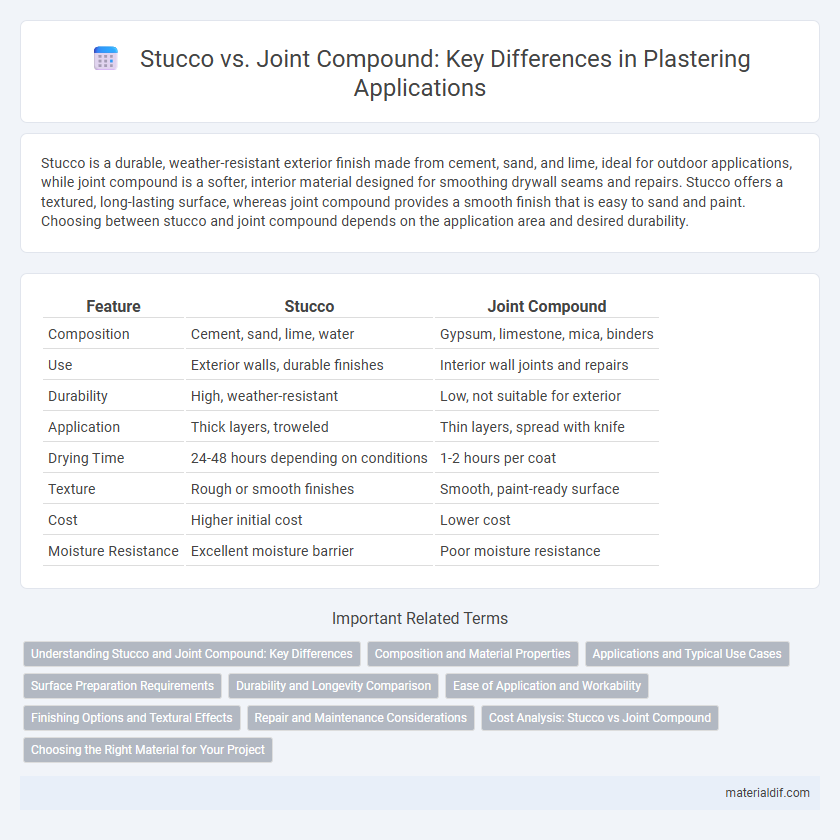Stucco is a durable, weather-resistant exterior finish made from cement, sand, and lime, ideal for outdoor applications, while joint compound is a softer, interior material designed for smoothing drywall seams and repairs. Stucco offers a textured, long-lasting surface, whereas joint compound provides a smooth finish that is easy to sand and paint. Choosing between stucco and joint compound depends on the application area and desired durability.
Table of Comparison
| Feature | Stucco | Joint Compound |
|---|---|---|
| Composition | Cement, sand, lime, water | Gypsum, limestone, mica, binders |
| Use | Exterior walls, durable finishes | Interior wall joints and repairs |
| Durability | High, weather-resistant | Low, not suitable for exterior |
| Application | Thick layers, troweled | Thin layers, spread with knife |
| Drying Time | 24-48 hours depending on conditions | 1-2 hours per coat |
| Texture | Rough or smooth finishes | Smooth, paint-ready surface |
| Cost | Higher initial cost | Lower cost |
| Moisture Resistance | Excellent moisture barrier | Poor moisture resistance |
Understanding Stucco and Joint Compound: Key Differences
Stucco is a durable exterior plaster made from cement, sand, and lime, designed for weather resistance and structural protection, while joint compound is a lightweight, interior drywall finishing material composed primarily of gypsum dust, water, and binders for easy application and sanding. Stucco provides a hard, textured surface suitable for exterior walls and architectural detailing, whereas joint compound is used to smooth drywall seams and repair minor surface imperfections indoors. The formulation differences result in stucco's toughness against elements contrasted with joint compound's ease of use and flexibility in interior refinishing tasks.
Composition and Material Properties
Stucco is primarily composed of cement, sand, and lime, resulting in a durable, weather-resistant finish ideal for exterior walls. Joint compound, made from gypsum dust mixed with water, provides a softer, more flexible material suitable for interior wall repairs and finishing drywall seams. The cementitious nature of stucco offers strong adhesion and moisture resistance, while joint compound's lightweight, smooth texture allows for easy sanding and sanding.
Applications and Typical Use Cases
Stucco is primarily used for exterior walls due to its durability and weather resistance, making it ideal for creating textured finishes on building facades. Joint compound, on the other hand, is commonly applied indoors for drywall repairs, taping, and creating smooth surfaces before painting. Each material serves distinct purposes, with stucco suited for outdoor architectural applications and joint compound for interior surface preparation and finishing.
Surface Preparation Requirements
Stucco surface preparation requires a clean, solid substrate free of dust, grease, or loose particles, often including a bonding agent or lath for proper adhesion. Joint compound application demands a smooth, drywall surface that is primed and free of cracks or holes to ensure uniform layering. Proper surface preparation for both materials prevents peeling and cracking, ensuring long-lasting finishes.
Durability and Longevity Comparison
Stucco offers superior durability compared to joint compound, as it is a cement-based material designed to withstand harsh weather conditions and resist cracking over time. Joint compound, primarily used for interior walls, is more prone to chipping and damage from moisture, resulting in a shorter lifespan. For exterior applications requiring long-lasting strength and resilience, stucco is the preferred choice due to its robust composition and weather-resistant properties.
Ease of Application and Workability
Stucco requires more skill and preparation due to its gritty texture and longer curing time, making it less forgiving for beginners compared to joint compound. Joint compound offers superior ease of application with its smooth, creamy consistency that spreads effortlessly and sands easily, ideal for detailed finishing and repairs. Its workability allows multiple coats and adjustments before drying, providing greater flexibility for precise wall smoothness.
Finishing Options and Textural Effects
Stucco offers durable finishing options with a rough, textured surface ideal for exterior applications, enhancing weather resistance and aesthetic appeal. Joint compound provides a smooth, fine finish primarily used indoors for seamless wall repairs and drywall finishing, allowing for paint-ready surfaces. Textural effects with stucco can range from coarse aggregates to decorative patterns, while joint compound allows subtle variations through troweling and sanding techniques for a polished look.
Repair and Maintenance Considerations
Stucco offers superior durability and weather resistance for exterior repair and maintenance, while joint compound is primarily designed for interior wall patching and smoothing. Stucco requires specialized tools and techniques for application, making it less suitable for minor touch-ups compared to the easier-to-use, quick-drying joint compound. Regular inspection of stucco is essential to address cracks and prevent moisture intrusion, whereas joint compound repairs are more frequent but simpler, often involving sanding and repainting.
Cost Analysis: Stucco vs Joint Compound
Stucco typically costs between $6 to $9 per square foot, making it a more expensive option compared to joint compound, which averages around $0.50 to $1 per square foot. The higher price of stucco is due to its durability, weather resistance, and application labor intensity, while joint compound serves as an economical choice primarily for interior wall finishing and minor repairs. Budget considerations should factor in long-term maintenance costs, as stucco generally requires less frequent upkeep compared to the more fragile joint compound.
Choosing the Right Material for Your Project
Stucco is a durable, weather-resistant exterior plaster ideal for outdoor applications and provides a textured finish. Joint compound, also known as drywall mud, is best suited for indoor use to smooth walls and fill gaps before painting. Choose stucco for exterior walls and joint compound for interior repairs to ensure optimal performance and longevity.
Stucco vs Joint compound Infographic

 materialdif.com
materialdif.com